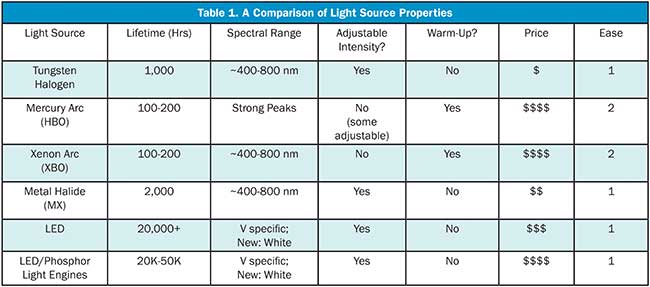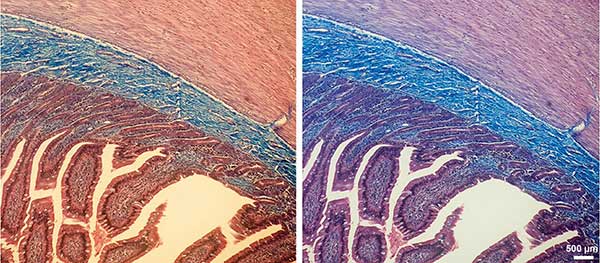
Microscopy Illumination: Considering Nonlaser Light Sources
BARBARA FOSTER, THE MICROSCOPY & IMAGING PLACE INC.
As recently as five years ago, shopping for a microscope light source was fairly straightforward. For routine applications, it was tungsten halogen, typically 100 W, while for fluorescence, it was an arc source, typically 100 W mercury. Today, there is a dizzying array of choices available from both the microscope vendors and independent third parties. Here is a quick review of the new nonlaser light sources and six questions to consider when buying a new system.
Fluorescence or not?
The first consideration when acquiring a new illumination system centers on the application. The question is, “Fluorescence or not?” For routine bright-field applications and related contrast techniques, 12 V/100 W tungsten halogen is still popular, but other options to consider include metal halide (MX) and LEDs. For fluorescence, traditional arc sources, such as mercury and xenon, still make up about 50 percent of the market. However, they are rapidly being replaced with metal halide systems, especially for samples emitting brighter fluorescence, and, more recently, the new LED illuminators and LED/phosphor light engines. As depicted in Table 1, each of these light sources has its advantages.
 Near-IR filters prevent washout
Near-IR filters prevent washout
As referenced in Table 1, many types of illuminators provide rheostats for adjusting intensity. However, turning the rheostat down on a tungsten halogen lamp causes a shift in color temperature from 5200 K blue white “daylight” to the warmer, yellow/red region around 3600 K (Figure 1). Since resolution and edge definition are wavelength dependent, this shift toward longer wavelengths degrades both. There is one other consideration when using these light sources: They often have high output in the infrared, invisible to the naked eye. If your images are washed out, consider using a near-infrared (NIR) filter in front of the camera.

Figure 1. Turning down the rheostat on a tungsten halogen
illuminator shifts the color and degrades resolution and edge
information. Courtesy of J. Sedgewick.
While it is tempting to adjust the intensity on these light sources with the rheostat, a better solution is the use of neutral density filters, often installed in the base of the microscope. For simpler systems or for a variable effect, place two polarizing filters covering the light port. Intensity will change continuously as one filter is rotated with respect to the other. When using this approach, confirm that the filters appear neutral gray, not tinged yellow or green. Also, because polarizing filters can be very heat-sensitive, be aware of the amount of heat emitted from the light port.
Moving from tungsten to metal halide
Metal halide systems provide a number of advantages: They enjoy a 10 times longer life span, are easily inserted into their mounts, are pre-aligned and are brighter than many of their halogen counterparts. In microscopes used for both bright-field and brighter fluorescence, they can often bridge the gap without requiring a second light source.
Another often overlooked challenge is the amount of light lost with widely used contrast techniques such as Phase and Hoffman Modulation Contrast (HMC). In both, the background illumination is dropped to approximately 18 percent, resulting in their soft dove-gray color.
Using a 546 nm green filter for optimum phase contrast drops the light even further. Polarized light is another culprit. Given that polarizers select only waves of a permitted direction of vibration, they automatically act as neutral density filters. Depending on the application, each of these contrast techniques may warrant a look at the higher intensity provided by metal halide lamps.
Full-spectrum white LEDs debut
Multiple factors are driving the rapid growth of LED illumination, but all of them center on the explosive growth in fluorescence. (Table 1.) The first factor is their extended lamp lifetimes, often on the order of 20,000 to 50,000 hours. A second is that they are instant on/instant off, requiring no warm-up time. By comparison, arc sources often require up to 15 minutes for the arc to stabilize. Also, because of their compact size and more limited heat output, LEDs can be grouped into a single lamp housing, making them attractive for multiwavelength experiments.
Finally, LEDs are undergoing aggressive development. Several years ago, their use in fluorescence was limited by poor output in green, a key fluorescence excitation wavelength especially for studies involving fluorescein isothiocyanate (FITC)
1. Limitations in other wavelengths affected other common fluorophores including auramine, acridine and Calcofluor. Those problems were resolved within two years of LED’s adoption. Within the past year, full-spectrum white LED became available. While results are not in yet, they could dramatically simplify both conventional and fluorescence illumination.
LED light sources for fluorescence are now available from all of the major manufacturers as well as highly respected third-party providers.
Six questions before buying
Having discussed what is available, here are six questions to ask before making that critical buying decision.
1. Who is going to use it?
Does the lab have one well-defined application or many different experiments requiring greater flexibility?
Also, how “expert” are the users? Do they need something straightforward or are they able to manage the greater complexities and care of working with arc sources? When installing an arc source, the microscopist must wear gloves to avoid leaving any oil residue that might weaken the glass envelopes at the arc lamp’s high operational temperature. Also, because these lamps are under high internal pressure, safety glasses are required. Finally, once installed, they must be aligned. Since each lamp housing has its own characteristics, the best reference for alignment is the microscope manufacturer.
2. What is the real power or spot intensity at the sample?
Will the lab be working with living cells, subject to phototoxicity, or fragile, light-sensitive materials? If so, the cooler output of LEDs might be a better solution. For microscopists who need to measure the real output of the illuminator at the sample plane, such systems are now available
2.
3. What wavelengths are important?
Figures 2 and 3 demonstrate the wide choices of wavelength available from various light sources. In the life sciences, the proliferation of new fluorophores has driven manufacturers of microscopes, filters and light sources to put together extensive reference materials to assure that all the components match the excitation and emission characteristics of those fluorophores. However, the old adage still holds true: Let the sample be your guide. For fluorophores such as FITC that have excitation at a strong mercury peak, compare the image produced by an old workhorse, such as a mercury arc with its intense, narrow peaks, to one of the newer metal halide, LED or light engine systems. For dyes with excitations falling in spectral ranges other than those peaks, LEDs or light engines are more likely to be a better answer.
Figure 2. Relative spectral output and intensity of a mercury arc (green), xenon arc (pink) and metal halide lamp (blue). Courtesy of SearchLight.
While fluorescence is not as widely used in the materials sciences, there are situations, such as imaging photosensitive materials, in which wavelength is critical. Again, let the sample be your guide. Try a different illuminator with your sample. It might be that the selectivity and intensity management of an LED or light engine will produce more controlled results.
4. Does the experiment require a shutter?
While there are a broad range of solutions now available on the market, if the experiment requires a filter wheel or physical shutter, consider how the illuminator is connected to the microscope. While a number of companies now provide direct-connection systems, for those instances where vibration from the shutter or filter wheel will be a problem, the distance provided by fiber optic connections is a better solution.
5. How important is stability?
While today’s light sources are much more stable, if an experiment will run hours or days, confirm that the stability of the system matches the procedure. Stability is also especially important in spectroscopy or any situation in which the intensity of light will be quantified.
Figure 3. LEDS are now available with high intensity across a wide range of wavelengths. Courtesy of CoolLED, Inc.
6. How much will it really cost?
Finally, consider the total cost of ownership. While the initial investment in an LED system might be high, its longer lamp life and ease of maintenance might well justify the investment. If LEDs are the solution and the system is connected to the microscope with a fiber optic cable, plan to replace the cable about every two years.
Meet the author
Barbara Foster is president and chief strategic consultant of The Microscopy & Imaging Place Inc. and Microscopy/Microscopy Education (MME) in McKinney, Texas; e-mail: bfoster@the-mip.com.
References
1. J. Beacher (February 2011). Microscope illumination: the LED revolution.
The Biomedical Scientist, pp.2-3.
2. B. Foster (June-July 2011). Fluorescence illumination: new metrics for reproducibility and quantitation.
BioPhotonics.
LATEST NEWS



